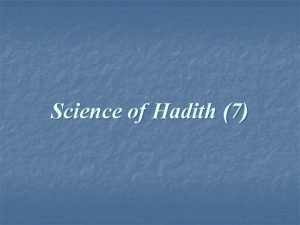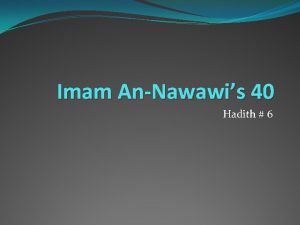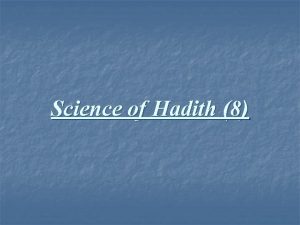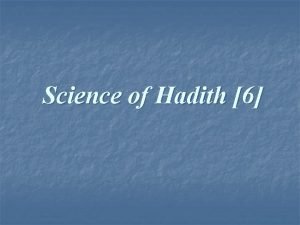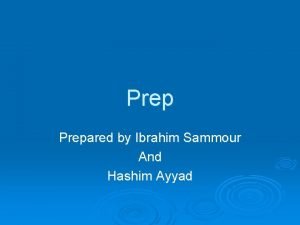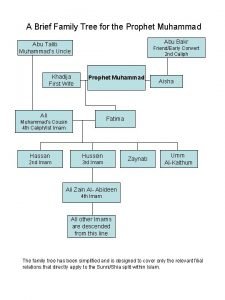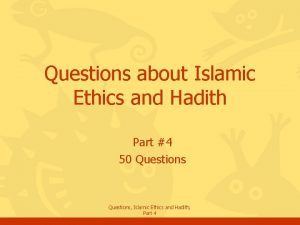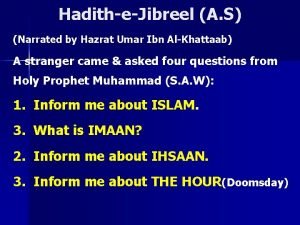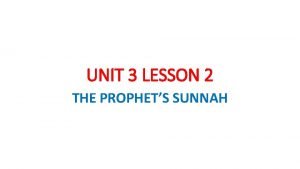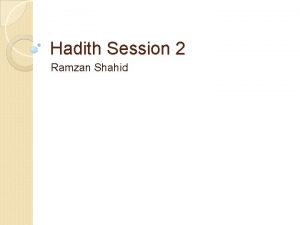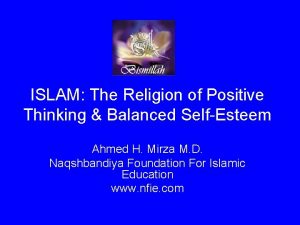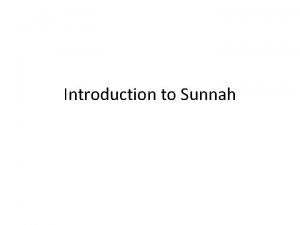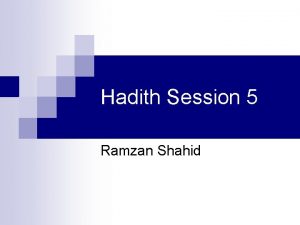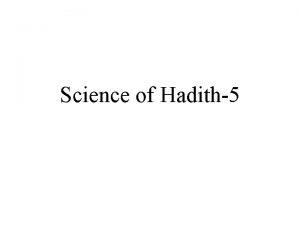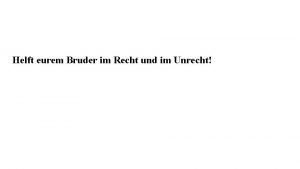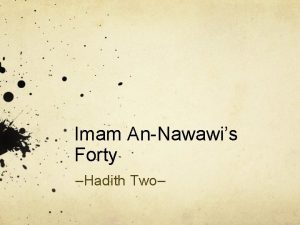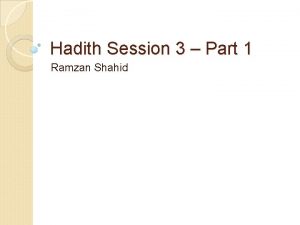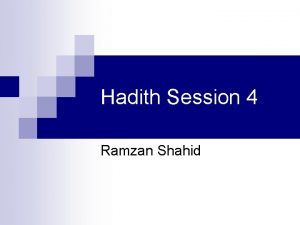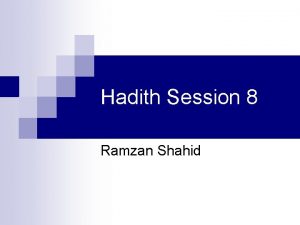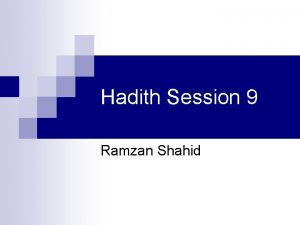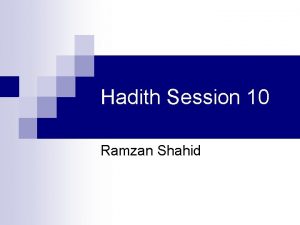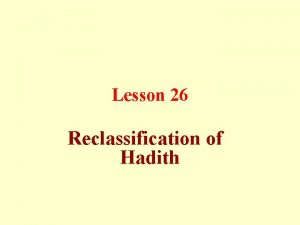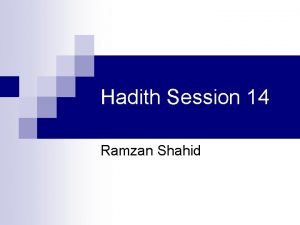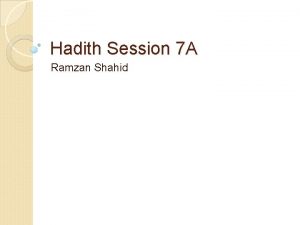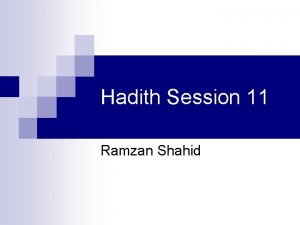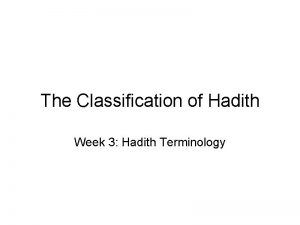Hadith Collection Sunni Version A S Hashim MD














































- Slides: 46

Hadith Collection, Sunni Version A. S. Hashim, MD

About this slide show: This slide show deals with: a. A general view of Hadith b. Categories of Hadith c. History of Hadith fabrications and forgeries d. I’lm Al-Rijaal e. Collection of Hadith during the 1 st, 2 nd, and 3 rd century f. Chain of Narration g. Collectors of Hadith and their books

What is Hadith? Hadith is a specific statement of Prophet Muhammad (pbuh) Traditions are deeds or conduct of Prophet Muhammad (pbuh) The Hadith and Sunnah are second in importance to the Quran The Holy Quran is God's Words and come first in significance and importance

Hadith Reporting Al-Hadith Sunni Shi’a Canonical Books

The Sunnah consists of: 1. The statements of Muhammad (pbuh) and 2. His Tradition (conduct) The Sayings are binding The Sunnah can be interpreted in several ways

The Shari'ah (Islamic Way) consists of: The Quranic Divine Guidance, and The Sunnah of Muhammad (pbuh) Shari'ah is the Constitution of Islam Shari'ah needs to be interpreted The interpreter of Shari'ah is called Faqeeh

Constitution of Islam Shari’ah Quran Sunnah The interpreter of Shari'ah is called Faqeeh

Fiqh (Islamic Law) Fiqh is interpretation of Shari'ah by a scholar erudite in Islamic knowledge Head of Islamic Schools of Thought is Faqeeh of the highest caliber Fiqh is the Law in Islamic Circles Fiqh is the spiritual law of unique importance to Muslims

The language of the Hadith The literary style of Hadith is very high, yet it is far different from the Quran Often the Hadith consists of a few words yet has deep meaning of immeasurable value Hadith may look like maxims and/or proverbs Hadith often touches on certain aspects of life

Subjects of Hadith 1. 2. 3. 4. 5. Hadiths deal with elements of Faith and Belief Hadiths deal with Rituals Hadiths deal with Human Character Hadiths deal with Ah’kaam and dealing with others Hadiths deal with the Afterlife

Categories of Hadith The scholars of the Hadith literature divided the Traditions of the Prophet (pbuh) into categories according to the degree of authenticity and reliability, each category had to meet certain criteria. The categories are as follows: Sahih: ﺻﺤـﻴـﺢ The genuine Traditions, the authentic ones. Moothaq: ﻣﻮﺛـﻖ Almost like the Sahih but the chain of narrators is not as strong as those of the Sahih. Hasan: ﺣـﺴـﻦ The fair Traditions although inferior in matter of authenticity. Dha'eef: ﺿـﻌﻴـﻒ The weak Traditions which are not so reliable.

Categories of Hadith Sahih: ﺻﺤـﻴـﺢ Moothaq: ﻣﻮﺛـﻖ Hasan: ﺣـﺴـﻦ Dha'eef: ﺿﻌﻴـﻒ

Classes of Deeds and Actions In the Shari'ah (Islamic Constitution) deeds and actions are divided into five classes: Fardh or Wajib: ﻭﺍﺟـﺐ ﺍﻭ ﻓﺮﺽ An obligatory duty the omission of which is Islamicly punishable. Mus'tahab: ﻣﺴـﺘـﺤﺐ An action which is rewarded, but whose omission is not punishable. Mu'baah: ﻣـﺒﺎﺡ An action which is permitted but legally is indifferent. Mak'rooh: ﻣﻜـﺮﻭﻩ An action which is disapproved by the Shari'ah but is not under any penalty. Haram: ﺣﺮﺍﻡ An action which is forbidden, and Islamicly punishable.

Narrators of Renown Abu Hurairah: A poor man, of the Saffah, in company of the Prophet for a short time (only 17 -19 months) Though an illiterate, he became governor over Bahrain, then over Medina (after Omar had died) Ibn Abbas: Was 13 years old when the Prophet died Was student of Imam Ali Ibn Omar Was 20 years old when the Prophet died Numerous other Sahaaba , not as prolific as the above 3

The Fabricated Hadiths: ﺍﻟﻤﺨﺘﻠﻘﻪ ﺍﻻﺣﺎﺩﻳﺖ History of Fabrication: During Benu Umayya's Rule: Bringing forth a Counterfeit Hadith was widespread throughout this period. During Benu Abbas' Rule, producing and circulating counterfeit Hadiths was widespread too, in particular with the advent of the schools of thought in Islam. By the year 200 H. : Total of 600, 000 Hadiths were in existence, out of which 408, 324 Hadith were fabricated (counterfeit) Hadiths by 620 forgers, whose names and identity are known. Most Notorious Forgers: Ibn Jundub, Abu Bukhtari, Ibn Basheer, Abdullah Al-Ansaari, Al-Sindi. One of them, Ibn Au'jaa, professed before he was hanged (for his heresy) that he alone had forged 4, 000 Hadiths.

Reasons for Fabricating Hadiths Reasons to Fabricate (To do Hadith forgery): 1. Financial incentive by the Khalifas, starting with 2. 3. 4. 5. Mu'awiya. Mu’awiya as an example awarded Ibn Jundub and others large sums of money for coming forth with Hadiths in his favor. As a means of self-promotion in the government. In a drive to enhance a particular school of thought. Fanaticism for a school of thought at the expense of others. Al-Qassassoon (The story-tellers): ﺍﻟﻘﺼــﺎﺻــﻮﻥ Their operation and major role in the public.

Size of Authentic versus Fabricated Hadith Less than 3, 000 Authentic Hadith Over 600, 000 Fabricated Hadiths as of 200 H

During the 1 st Century H. The early Khalifas discouraged putting the Hadith in writing, They encouraged committing the Hadith to memory. Ali differed from them and wrote 580 Hadiths. It was soon discovered that the quotes of the Hadith were inaccurate For one thing many of the Sahaaba had died, and for another, that committing Hadiths to memory was not that reliable Al-Zuhri, Al-Hazm were both commissioned by Khalifa Omar Ibn Abdul Aziz to collect the Hadith but the work was probably not done, due to early death of the Khalifa in 101 H. No record of their work exists.

During the 2 nd Century H. Collection of Hadith was mainly by: Ibn Jarih, Al-Thawri, Ibn Basheer, and Malik Ibn Anas in his Mu'watta. The necessity of I'lm Al-Rijaal, ﺍﻟﺮﺟﺎﻝ ﻋﻠﻢ (Science of men of Hadith Transmitters) became necessary because of the numerous counterfeit Hadiths circulated at the time. Compiling books about forged (counterfeit) Hadiths: This was necessary to warn the Scholars and the public about the multitude of the forged Hadiths at that time.

During the 3 rd Century H. Hadith was collected and categorized in the third century of Hijrah resulting in six canonical collections called (Al-Sihaah Al-Sittah): Al-Bukhari, d. 256 A. H: ﺑﺨﺎﺭﻯ ﺻـﺤﻴـﺢ Selected 7275 (2712 Nonduplicated) out of 600, 000 available Hadiths he was aware of. Muslim, d. 261 A. H: ﻣﺴـﻠﻢ ﺻـﺤﻴـﺢ Selected 9200 (3, 033 Nonduplicated) out of 300, 000 available Hadiths he was aware of. Abu Dawood, d. 276 A. H. ﺩﺍﻭﺩ ﺍﺑﻮ ﺳﻨﻦ Selected 4, 800 of 500, 000 available Hadiths he was aware of. . Ibn Maajeh: d. 273 A. H. ﻣﺎﺟﻪ ﺍﺑﻦ ﺳــــﻨﻦ Selected 5274 Hadiths Tirmidhi, d. 279 A. H. ﺍﻟﺘﺮﻣﺬﻯ ﺟـــﺎﻣﻊ He was blind. al-Nisaa'i, d. 303 A. H. ﺍﻟﻨﺴـﺎﺋﻲ ﺳـﻨﻦ It is worthy of note that the number of the Shi'a transmitters of Hadith whose quotes appear in the Al-Sihaah Al-Sittah is over 300.

The necessity for I'lm Al-Rijaal, ﺍﻟﺮﺟﺎﻝ ﻋﻠﻢ The necessity of I'lm Al-Rijaal, ﺍﻟﺮﺟﺎﻝ ﻋﻠﻢ (Science of men of Hadith Transmitters): Considered before reliability of the narrator could be established, were: 1. The Background, 2. Intelligence, 3. Authenticity, 4. Reliability, 5. Capacity to Memorize, 6. Manner of living, 7. Reputation, and 8. Criticism,

By the year 200 H. Total of 600, 000 Hadiths were in existence, The fabricated Hadiths numbered 408, 324 The fabricated Hadiths were traced to 620 forgers, The names of the forgers and their identity were registered. Ibn Abi Awjaa as an example, claimed before his execution he forged 4, 000 Hadiths by himself. Alphabetized names of fabricators, their background and references, are available in Book of Al-Ghadeer, Vol. 5 Page 208

Notorious Forgers Ibn Jundub, ﺟﻨﺪﺏ ﺍﺑﻦ Abu Bukhtari, ﺍﻟﺒﺨﺘﺮﻱ Ibn Basheer, ﺑﺸﻴﺮ ﺍﺑﻦ Abdullah Al-Ansaari, ﺍﻷﻨﺼﺎﺭﻱ ﺍﻟﻠﻪ ﻋﺒﺪ Al-Sindi. ﺍﻟﺴﻨﺪﻱ Ibn Au'jaa, ﺍﻟﻌﻮﺟﺎﺀ ﺍﺑﻲ ﺍﺑﻦ who professed before he was hanged (for his heresy) that he alone had forged 4, 000 Hadiths.

Hadith Books There are 6 Canonical Treatises (Sunni) There are 4 Canonical Treatises (Shi'a) Each treatise consists of 6 -12 volumes There about 2, 000 -3, 000 authentic Hadiths, and many more that are reliable (less than authentic).

To Follow the Shari'ah To be a person of piety (Taq'wa) a Muslim strives to: 1. 2. 3. Follow the Quran Apply the Hadith's instructions Emulate the conduct of Prophet Muhammad (pbuh) 4. By so doing he/she will have achieved the perfection of character and gained Heaven

Sunni Hadith Collection Early in Islam, many people claimed to have committed the Hadith to memory, generation after another, but Hadith was not registered Collection and registering of Hadith in distinctive book format began 200 to 300 years after Muhammad (pbuh) had passed away Chain of Hadith Narration was recorded for authenticity's sake Such an endeavor took a life time of hard work on the part of the Hadith collector

Sunni Hadith Collection Books of Hadith by the Sunni were written 240 -300 years after Hijrah Six canonical books were the result They are called the 6 authentic books (Al. Sihaah Al-Sittah) Some of these books are more prized than others (such as Bukhari and Muslim)

Sunni Canonical Collections 1. 2. 3. 4. 5. 6. Sahih of Al-Bukhari, d. 256 A. H: ﺑﺨﺎﺭﻯ ﺻـﺤﻴـﺢ Sahih of Muslim, d. 261 A. H: ﻣﺴـﻠﻢ ﺻـﺤﻴـﺢ Sunan Ibn Maajeh: d. 273 A. H. ﻣﺎﺟﻪ ﺍﺑﻦ ﺳــﻨﻦ Sunan of Abu Dawood, d. 276 A. H. ﺩﺍﻭﺩ ﺍﺑﻮ ﺳﻨﻦ Jami' of Tirmidhi, d. 279 A. H. ﺍﻟﺘــــﺮﻣـﺬﻯ ﺟـــﺎﻣﻊ Sunan of al-Nisaa'i, d. 303 A. H. ﺍﻟﻨﺴﺎﺋﻲ ﺳــﻨﻦ

Sunni Hadith Collection: 3 rd Century Collected by Book Age Bukhari Sahih Bukhari 194 -256 H Muslim Sahih Muslim 204 -261 H Ibn Maajeh Sunan Ibn Maajeh 209 -273 H Abu Dawood Sunan Abu Dawood 203 -276 H Tirmidhi Jami' of Tirmidhi 209 -279 H al-Nisaa'i Sunan al-Nisaa'i 215 -303 H

Sunni Hadith Collection Hadiths quotes were taken from the Sahaaba The second generation took the Hadith from the Sahaaba, and were called Al-Tabi’een Collectors of Hadith in the 3 rd century had to go through a chain of narrators to reach the Sahaaba and/or Tabi’een Collectors of Hadith put forth criteria as guidelines to accept or reject any specific Hadith The arduous job was to sift through 600, 000 “Hadiths” available at the time to choose what is authentic In contrast the Shi’a quoted the Imams who quoted their forefathers up to the Prophet. The process continued for 329 years

Collectors of Hadith, 3 rd Century 1. Al-Bukhari 2. Muslim 6. Ibn Maajeh Hadiths 3. Abu Dawood 5. al-Nisaa'i 4. al-Tirmidhi

Al-Bukhari, 194 -256 H: ﺍﻟﺒﺨﺎﺭﻱ Al-Bukhari's mother tongue was Persian for he was born in Bukhara. Part of Persia in those days. He collected the Hadith over a period of many years, having established certain strict criteria. Political times during Bukhari’s lifetime were very troublesome especially against Ahlul Bayt (led by Al‑Mutawak'kil )ﺍﻟﻤﺘﻮﻛﻞ. As a consequence Bukhari was cautious and circumspect, having mentioned less about Ahlul Bayt's narrations than any of the Al-Sihaah Al-Sittah.

Al-Bukhari was born to a slave family of Bukhara in 194 H. His father died while Bukhari was a child, leaving him a considerable fortune. Bukhari was of weak physique, but with strong intellect, sharp retentive memory, great capacity for hard work, he was methodical. He began to study Hadith at the early age of eleven. Then he went to Mecca for pilgrimage from where he took a journey for the collection of Hadith. He traveled nearly forty years in quest of knowledge throughout the Muslim world. He then returned to Nishapoor in Iran but he had to leave as he could not yield to the wishes of the Governor. Bukhari settled afterwards in a village at Samarkand where he died at the age of 62 years in 256 H. It has been said by some that he died in Baghdad. ـ

Al-Bukhari Throughout his life Bukhari was pious, and the Prophet's Tradition was his hobby while archery was his pastime. He selected 2712 non-duplicated Hadiths which became 7, 275 when duplicated by many narrators. The fact is that if one Hadith was narrated by six narrators, then this Hadith was reported as 6 Hadiths though with minor variation in expression of the Hadith in question. Thus the number of Hadiths would increase depending on how many narrators report it. These Hadiths were selected out of 600, 000 Traditions available to him at the time. It can be said that Bukhari found the remaining 592, 725 Hadiths of unworthy basis and were to be ignored. Bukhari therefore chose only one Hadith out of every 200 ones, meaning 0. 5%, the rest were deemed forged (fabricated).

Muslim, 204 -261 H: ﻣﺴﻠﻢ It is said Muslim was a student of Al-Bukhari and 8 years younger. He differed from Bukhari in his methodology and criteria. He collected the Hadith over a number of years, having established his own criteria. Political times then were less troublesome against Ahlul Bayt, (since Al-Mutawak'kil was killed by his own son), therefore Muslim narrated a large number of Hadiths about Ahlul Bayt. Muslim al-Nishapoori was born in a distinguished family of Arab Muslims in Khurasan, Iran in 204 H, and his mother tongue was Persian for he was born in Nishapoor of Persia. His forefathers occupied prominent positions during the time of four Khalifas; and Muslim himself inherited a large fortune from his father who was also a Traditionist of some repute. Muslim died in the year 261 H.

Muslim Sahih of Muslim is considered as next to Bukhari in authenticity. It is somewhat superior to Bukhari's work in the details of arrangement of Traditions. The commentary of this book can be found in Ibn Khalikan's work Vol. II, Page 91, and in Fehrist (page 231). Sahih Muslim contains 3, 033 non-duplicated Hadiths, becoming 9, 200 when duplicates are registered. These Hadiths were selected out of 300, 000 circulating Hadiths he was aware of.

Abu Dawood 203 -276 H ﺩﺍﻭﺩ ﺍﺑﻮ Abu Dawood received his education in Tradition at Khurasan, in Iran. He was so respected by the people that after the city was devastated by Zinjies (the Blacks), he was requested by the Khalifa al‑Mu'tadhid to settle there so as to attract people and students due to his presence. He agreed, but refused to be the teacher to the Commander's son. He adamantly refused the son of the Abbasi General (the founder of the Suffari dynasty) but rather be available to other students. Abu Dawood wrote many books on Tradition and Islamic laws of which his “Sunan” is the most important. The Sunan contains 4, 800 Traditions which were sifted from 500, 000 Hadiths he was aware of. This work took him nearly 20 years.

al-Tirmidhi: 209 -279 H ﺍﻟﺘﺮﻣﺬﻯ This is another standard work on Hadith and is considered by the Sunni Muslim jurists as one of the six authentic Traditions works. Tirmidhi was the first man to determine the identity of the names, surnames, and titles of the narrators of Traditions.

al-Nisaa'i 215 -303 H: ﺍﻟﻨﺴﺎﺋﻲ Al-Nisaa'i made a good Hadith collection, quite credible. He wrote Al-Khasa'is book, about the eminence of Imam Ali and Ahlul Bayt and the Hadiths on their behalf. Al-Nisaa'i was 88 years old when in Damascus he expressed his views about Mu'awiya by saying, “All I know is that the Prophet (pbuh) said, `May Allah make a glutton out of him. ” Infuriated, Mu'awiya's sympathizers attacked al-Nisaa'i, trampled upon him, crushed his testicles, and after that the infirm Nisaa'i was taken to Mecca where he died. He was buried between Safa and Marwa.

al-Nisaa'i Sunan of al‑Nisaa'i work on Tradition has been recognized as the best Tradition work of his time, His smaller work is now considered as one of the Sihaah Sittah. He was the foremost Traditionist of his age and spared no pains in having Hadith recorded in his Sunan. He admitted that in his work there are many weak and doubtful Hadiths (Traditions).

Ibn Maajeh 209 -295 H: ﻣﺎﺟﻪ ﺍﺑﻦ Born in Qazween, Iran in 209 H The Abbasid Empire was then at its peak of civilization and power, and Al-Ma'Moon was the influential Khalifa, who led the Caliphate toward progress and an Islamic-spirited renaissance. At the age of 22 Ibn Maajeh set out on his journey in 230 H to learn Hadith from scholars. He traveled to Khurasan, Basra, Kufa, Baghdad, Damascus, Mecca, Medina, and Egypt. After an arduous 15 years, Ibn Maajeh turned back to Qazween, writing, classifying, and narrating Hadiths. His fame grew far and wide and seekers of knowledge came to him. The only surviving book written by Ibn Maajeh is Sunan. This book has achieved widespread fame and gave him renown and prestigious status among the scholars of Hadith

Imam Ahmad, 164 -241 H: ﺍﺣﻤﺪ ﻣﺎﻡ Imam Ahmad was born in Baghdad, and his was the most important and exhaustive of all Mus'nad works. His pious and selfless life created a halo of sanctity around his great collection of Traditions and in spite of its great bulk, it survived the vicissitude of time and revolution of empires. His Mus'nad contains 30, 000 Traditions on various subjects, reported by as many as 700 companions of the Prophet. He died before he gave his works a final shape and his son Abdullah completed it in the course of 13 years. This book occupied a very important position in Hadith literature and served for a long time as the chief source of Hadith. It was read up to the 12 th century. Afterwards it fell into relative disfavor owing to other better works.

Collection of al-Hadith Al-Sihah Al-Sittah (Sunni) Registered by highly Qualified scholars in Islam Narration of Ahlul Bayt (Shi'a) Registered by highly Qualified scholars in Islam Quoting various people whose narration went back to the Prophet’s companions and Tabi’een, then to Muhammad (pbuh) himself. Quoted from the 12 Imams (Ahlul Bayt). Narration was straight through to Muhammad (pbuh) by way of Ali’s registration of Hadiths.

Manner of Collection of al-Hadith Collection Al-Sihaah Al-Sittah Quoted from Two generations: Sahaaba and Tabi’een Narration of Ahlul Bayt Quoted from Twelve generations, the Imams, over a period of 329 years

In Conclusion General discussion of Hadith with the Sunni 1. 2. 3. 4. 5. 6. A general view of Hadith Categories of Hadith fabrications and forgeries I’lm Al-Rijaal Hadith during the 1 st, 2 nd, and 3 rd, century Collectors of Hadith and their books

THANK YOU Be in Allah’s Care Dr. A. S. Hashim
 Sunni hadis
Sunni hadis Hadith 30 of annawawis collection
Hadith 30 of annawawis collection Lessons from hadith 18 of annawawis collection
Lessons from hadith 18 of annawawis collection Tadlees in hadith
Tadlees in hadith Hadith 6 of an nawawi
Hadith 6 of an nawawi Lessons from hadith 17 of annawawis collection
Lessons from hadith 17 of annawawis collection Hadith 8 of annawawis collection
Hadith 8 of annawawis collection Hadith 23 of annawawis collection
Hadith 23 of annawawis collection Hadith 38 of annawawis collection
Hadith 38 of annawawis collection Hadith 32 of annawawis collection
Hadith 32 of annawawis collection Daeef hadith
Daeef hadith Hadith 35
Hadith 35 10 good manners in islam
10 good manners in islam Dr mark hashim
Dr mark hashim Boycott of banu hashim
Boycott of banu hashim Oumar hachim
Oumar hachim Family tree of quraish tribe
Family tree of quraish tribe Hayder hashim md
Hayder hashim md Dr ahmed hashim
Dr ahmed hashim Why is charlie telling hashim jokes?
Why is charlie telling hashim jokes? Berniaga emas
Berniaga emas Dr ahmed hashim
Dr ahmed hashim Ahmed hashim ibrahim
Ahmed hashim ibrahim My favourite subject is science because
My favourite subject is science because Ang unang estadong naitatag sa kanlurang africa ay ang
Ang unang estadong naitatag sa kanlurang africa ay ang Sectarianizing
Sectarianizing Shia-sunni differences chart
Shia-sunni differences chart Muhammad uncle name
Muhammad uncle name Sunni vs shia differences chart
Sunni vs shia differences chart Khaled hosseini shia or sunni
Khaled hosseini shia or sunni Branches of sunni islam
Branches of sunni islam Landsat collection 1 vs collection 2
Landsat collection 1 vs collection 2 Documentary collection definition
Documentary collection definition Hadees on relatives
Hadees on relatives Hadith e jibreel explanation
Hadith e jibreel explanation Sunnah of prophet muhammad
Sunnah of prophet muhammad Hadith e taqreeri meaning
Hadith e taqreeri meaning Hadith on gratefulness
Hadith on gratefulness Hadith about extravagance
Hadith about extravagance Nafs e mulhima
Nafs e mulhima Sunnah meaning
Sunnah meaning Hadith of the day
Hadith of the day Maudu hadith
Maudu hadith Bilal ibn rabah title
Bilal ibn rabah title Hassan hadith
Hassan hadith Hadith on business ethics
Hadith on business ethics Asabiyya hadith
Asabiyya hadith



